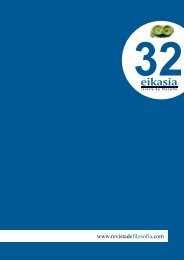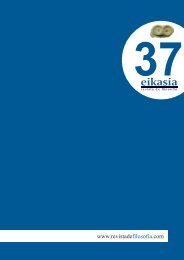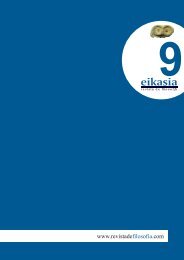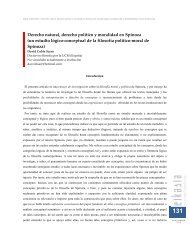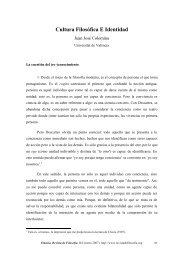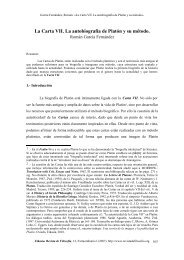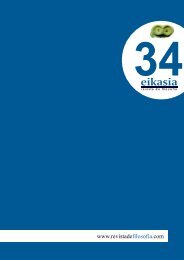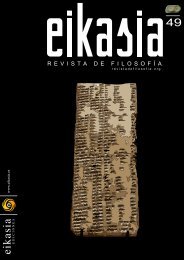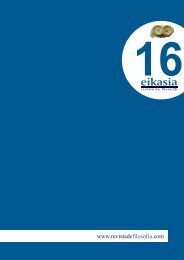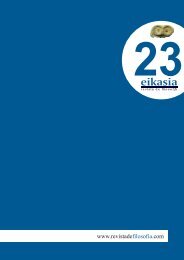Descargar número completo (4,15 MB) - Eikasia
Descargar número completo (4,15 MB) - Eikasia
Descargar número completo (4,15 MB) - Eikasia
You also want an ePaper? Increase the reach of your titles
YUMPU automatically turns print PDFs into web optimized ePapers that Google loves.
Fernando Miguel Pérez Herranz | A topological model for consciousness: the four original forms of consciousness<br />
A topological model for consciousness: the four original forms of consciousness<br />
Fernando Miguel Pérez Herranz<br />
Universidad de Alicante<br />
Abstract<br />
In this second CFN (r) symposium I would like to stress the need<br />
to recover a way of thinking according to analogical logic as<br />
opposed to the (exhausted) univocal model of thinking that<br />
excludes science and refers to it only through the principle of noncontradiction<br />
(neo-positivism); and as opposed to the<br />
(inconsistent) equivocal model of thinking in which "anything<br />
goes", so long as it is upheld by some human group<br />
(postmodernism.) I will deal with three issues:<br />
1) From the Scotist and nominalist criticisms to overcome the<br />
absolute omnipotence of God, the material substrate of the world<br />
becomes a meaningless power, ready for whatever human reason<br />
decides. Science is no longer knowledge at the service of<br />
intelligibility and will have no more unity than methodological<br />
unity; its resources will be: testing, experimenting, and<br />
quantifying within a logical argument that ensures the coherence<br />
of all these operations. This will also have ethical and moral<br />
implications; thus, the Kantian project, along the lines of Scotus<br />
and Luther, concentrates its efforts in proclaiming the autonomy of<br />
the moral world against the deterministic nature of physical laws.<br />
Nature ceases to be the bearer of values and goals - of dignity -,<br />
and, therefore, it is seen as corrupt nature (Luther, Calvin) which<br />
is entirely unable to entail legality, let alone to justify any moral<br />
standards that impose duties heteronomously to the consciousness.<br />
Aristotelian philosophy, analogical, takes into account unity in<br />
diversity. The exercise of human intelligence, of intelligibility,<br />
governs two key perspectives: 1) the purpose of intelligibility<br />
(practical philosophy) and 2) the form of intelligibility (theoretical<br />
philosophy, ontology or metaphysics in the Aristotelian sense,<br />
semiotics). The totality of knowledge has to do with the analogical<br />
unity of specifically diverse multiple notions. The analogical<br />
philosophy based on the Aristotelian model deactivates,<br />
consequently, the supposedly indefinite will of the subject; hazard,<br />
the principle of entities; the pure emergency, pure creativity.<br />
2) Secondly, I will propose a model for consciousness. In a paper<br />
presented at Urbino (Italy), I showed that research on the brain is<br />
characterized by the absence of a theorem of consciousness. There<br />
is nothing similar to the "the double helix theory" in molecular<br />
biology. Vilanayur Ramachandran suggests that this role could be<br />
played by mirror cells: "I predict that mirror neurons will do for<br />
psychology What DNA did for biology." But whether or not this is<br />
true, Ramachandran sets us on different path from standard<br />
programs: the theorem of consciousness must emerge not from the<br />
study of single brain and the physiological processes that occur<br />
within it, but from opening up to the investigation to the<br />
connection between two brains, at least. This proposal is inspired<br />
by the René Thom model to account for the predator/prey<br />
relationship. According to the biological interpretation of the<br />
model, a cat and a mouse are understood to form a topological unit<br />
or logos. These two actants [cat and mouse] are related in an<br />
irreversible manner, which implies the thesis of the unidirectional<br />
collision. The cat sees the mouse (J); it chases it (JRK); the<br />
mouse can escape or be eaten (bimodality); ( K ) and the cat<br />
sleeps, becoming its own prey (KSJ) (Fig. 1).<br />
[Identity: ”The predator is its own prey” Perception /Capture]<br />
Fig. 1. Thom's predator/prey model<br />
The model is justified by appealing to the theory of stable<br />
singularities. The transformations of points from unstable to stable<br />
can be understood as the collision of a wave front on a plane. As<br />
the wave front propagates on the plane it sweeps an area of spacetime.<br />
The surface, in turn, can be understood as another wave<br />
front. The complexity of the waves means that only certain<br />
sections can be studied. (Fig. 2)<br />
Fig. 2. Colliding waves<br />
The intuitive strategy that we will be presenting begins with the<br />
representation of the elliptical umbilical with its four singular<br />
points; the space between phases is plotted formula V ( x, y ) = x ²<br />
and - and ³ / 3 and then we join the paths oriented according to the<br />
eigenvectors of the isolated points, so that we obtain a figure like<br />
the one below where we can intuitively "see" how to connect all<br />
the attractors:<br />
Fig. 3. Connection of attractors<br />
167<br />
MARZO<br />
2012



